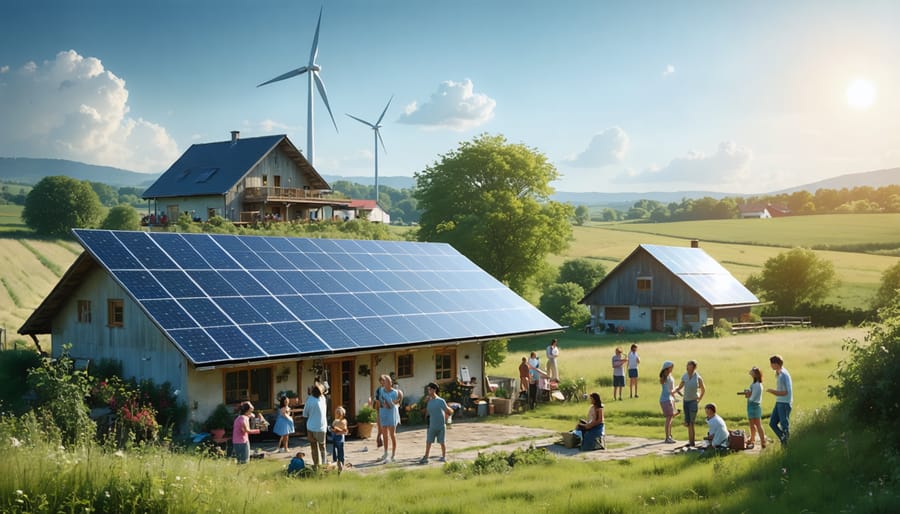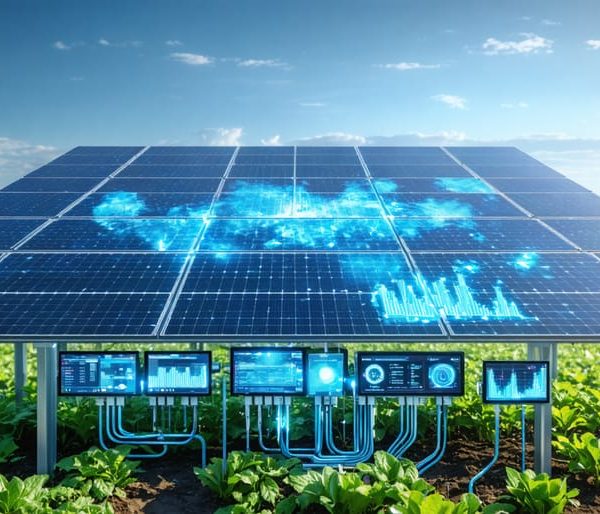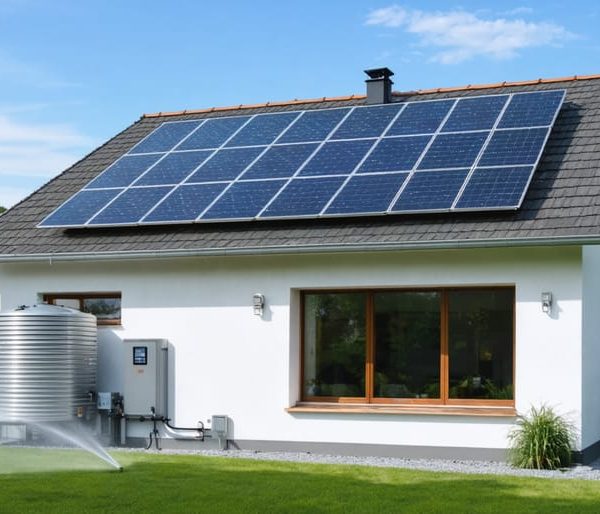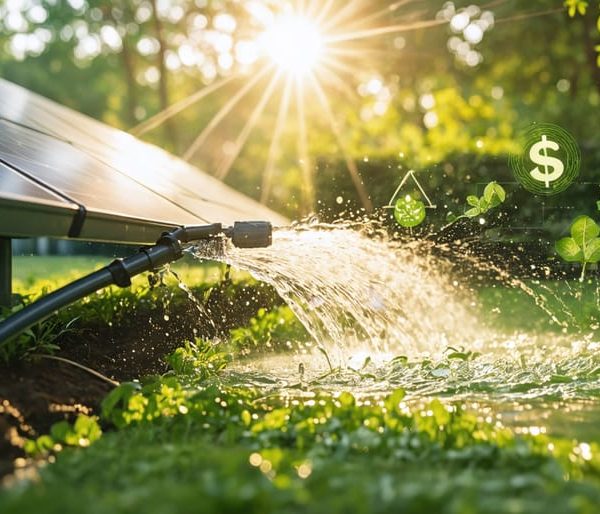Solar Solutions That Keep Rural Communities Powered When Disaster Strikes
Transform rural energy infrastructure by integrating solar microgrids, wind power systems, and smart storage solutions to achieve complete power independence in remote areas. Modern energy improvements now make it possible for rural communities to slash utility costs by 60-80% while strengthening their resilience against grid failures and natural disasters.
Rural property owners are increasingly turning to hybrid energy systems – combining solar panels, battery storage, and efficient appliances – to create self-sustaining power networks that operate independently from traditional utility grids. These innovations aren’t just about keeping the lights on; they’re revolutionizing how remote communities access, store, and manage their energy resources.
By implementing smart meters, energy-efficient LED lighting, and automated load management systems, rural households can optimize their power consumption while maintaining reliable access to electricity. This practical approach to energy independence helps remote communities weather storms, reduce environmental impact, and build sustainable infrastructure for future generations.
Why Rural Areas Need Special Energy Solutions
The Rural Energy Security Challenge
Rural communities face unique challenges when it comes to energy security and grid reliability. Unlike urban areas with multiple power distribution routes and faster repair response times, rural regions often rely on single transmission lines stretching across vast distances. This makes them particularly vulnerable to weather-related outages and equipment failures.
When severe weather strikes, rural areas typically experience longer power restoration times – sometimes days or weeks compared to hours in cities. This extended downtime can have serious consequences for farming operations, home-based businesses, and essential services like water pumping and medical equipment.
The aging infrastructure in many rural areas compounds these challenges. Many power lines and transformers are decades old, making them more susceptible to failure and less efficient at power delivery. Additionally, the lower population density means fewer utility crews are stationed nearby, resulting in longer wait times for repairs.
These vulnerabilities highlight the growing need for rural communities to explore energy independence solutions. By implementing local power generation and storage systems, rural residents can better protect themselves against extended outages and ensure their essential operations continue uninterrupted.
Impact of Natural Disasters on Rural Power Systems
Rural power systems face unique challenges when natural disasters strike, often experiencing more severe and longer-lasting impacts than urban areas. Recent statistics show that rural communities typically wait 2-3 times longer for power restoration after major storms compared to urban areas.
During Hurricane Laura in 2020, over 90% of rural Louisiana’s power infrastructure suffered damage, with some communities waiting up to three weeks for repairs. Similarly, the 2021 Texas winter storm left nearly 1 million rural residents without power for an average of 5.5 days, compared to 2-3 days in urban areas.
The vulnerability of rural power systems stems from several factors. Long transmission lines running through remote terrain are more susceptible to damage from falling trees and ice accumulation. Limited access roads can delay repair crews, while sparse population density means fewer backup systems are in place.
The financial impact is equally significant. Rural electric cooperatives often spend 50% more per customer on disaster recovery compared to urban utilities, straining already limited resources. These challenges highlight the critical need for resilient power solutions and strategic infrastructure improvements in rural communities.
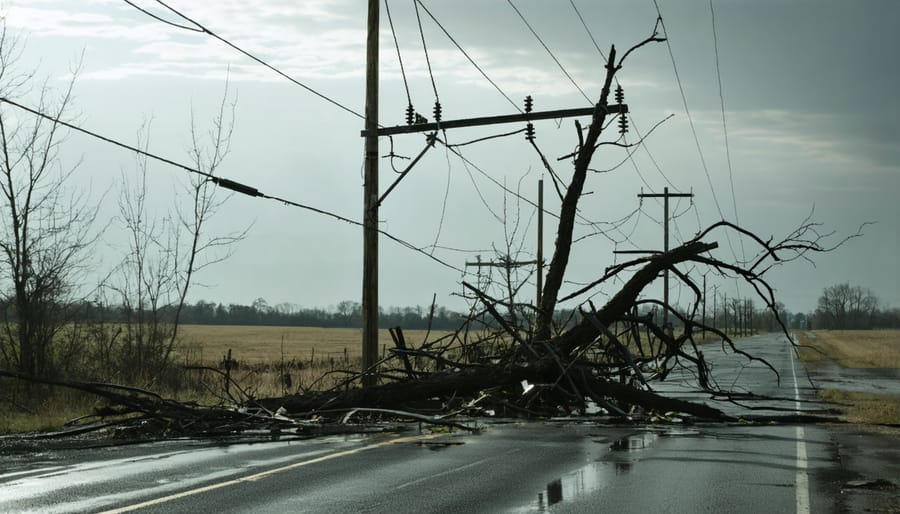
Solar-Powered Solutions for Rural Resilience
Stand-Alone Solar Systems
Stand-alone or off-grid solar power systems offer rural homeowners complete energy independence by harnessing the sun’s power to generate electricity. These systems typically consist of solar panels, batteries for energy storage, charge controllers, and inverters that work together to provide reliable power throughout the day and night.
For a typical rural home, installation begins with mounting solar panels on the roof or in a dedicated ground array. The panels convert sunlight into electricity, which is then stored in deep-cycle batteries for use during cloudy days and nighttime. A charge controller manages the flow of electricity from the panels to the batteries, preventing overcharging and extending battery life.
Many rural homeowners find that a 5-10kW system adequately meets their daily energy needs, powering everything from basic appliances to farm equipment. The initial setup costs are offset by eliminated utility bills and potential tax incentives. Plus, these systems require minimal maintenance beyond occasional panel cleaning and battery checks.
Success stories from rural adopters show that stand-alone solar systems not only provide reliable power but also offer protection against grid outages and rising energy costs. Whether you’re powering a small farmhouse or a large agricultural operation, these systems can be scaled to meet your specific needs while contributing to a more sustainable future.
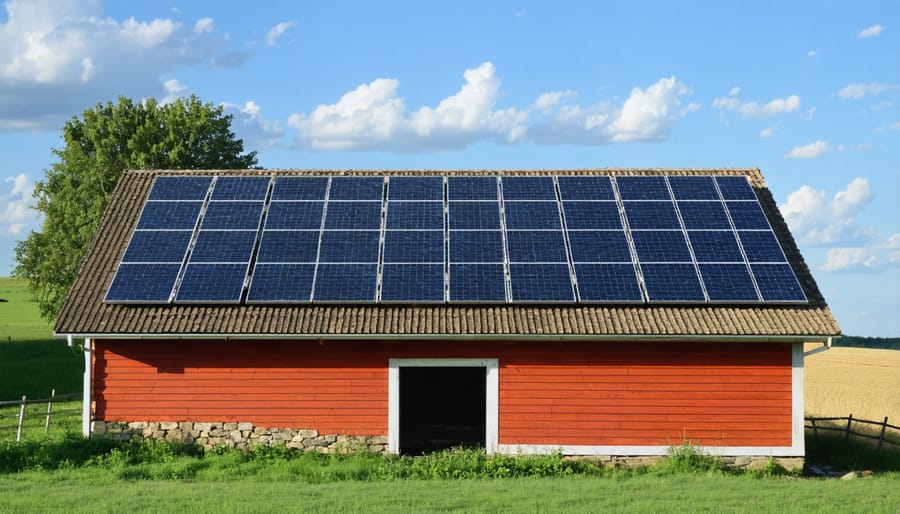
Community Solar Microgrids
Community solar microgrids are revolutionizing how rural areas access and share renewable energy. These innovative community solar projects allow neighbors to pool their resources and create a shared power system that benefits everyone involved.
Instead of each household installing their own solar panels, community members contribute to a centralized solar installation that serves multiple properties. This approach significantly reduces individual installation costs while providing clean, reliable energy to the entire community. The microgrid system includes battery storage solutions that ensure power availability even during cloudy days or nighttime hours.
The benefits extend beyond cost savings. These systems create energy independence for rural communities, reducing their reliance on traditional power grids that may be unreliable or expensive to maintain. During natural disasters or grid failures, community microgrids can continue providing power to essential services like medical facilities, emergency shelters, and water pumping stations.
Many rural communities have reported up to 30% reduction in their energy costs after implementing solar microgrids. The shared maintenance responsibilities make the system more sustainable long-term, while the collective approach strengthens community bonds. Some neighborhoods have even generated extra income by selling surplus power back to the grid, creating a new revenue stream for community projects.
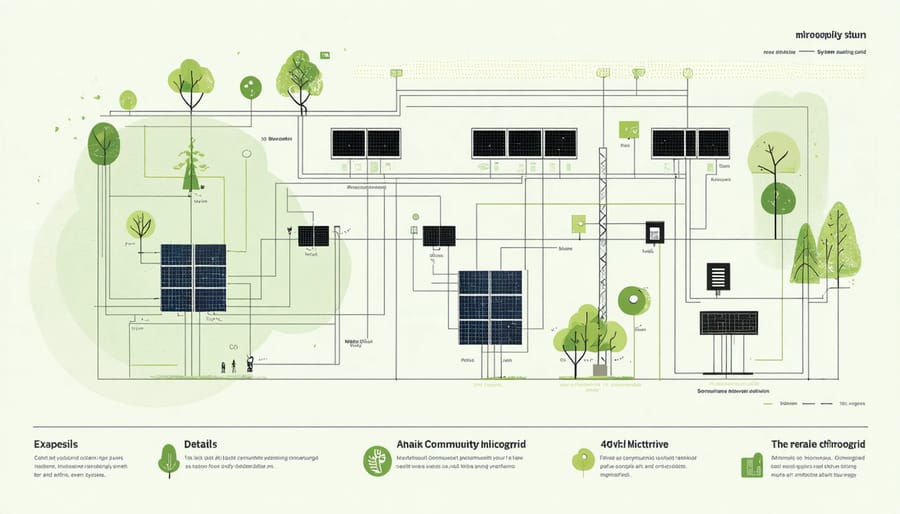
Solar-Powered Emergency Services
In emergency situations, reliable power becomes crucial for maintaining essential services in rural and remote areas. Solar-powered emergency systems have emerged as a game-changing solution, providing dependable backup power when traditional grid systems fail. These systems can keep critical facilities running, including medical centers, emergency shelters, and communication infrastructure.
A well-designed solar emergency system typically includes solar panels, battery storage, and an intelligent control system. During natural disasters or grid failures, these systems automatically kick in, ensuring continuous power supply for emergency lighting, medical equipment, and communication devices. Many rural communities have successfully implemented these systems at their fire stations, medical clinics, and community centers.
For example, the Thompson Valley Medical Center in rural Colorado installed a solar emergency system that proved invaluable during a severe winter storm. The system powered essential medical equipment and heating systems for three days while the main grid was down, potentially saving lives.
To maximize effectiveness, communities should:
– Install battery storage systems alongside solar panels
– Regularly maintain and test emergency power systems
– Train local staff in basic system operation
– Create clear protocols for emergency power management
– Establish backup communication systems
Solar-powered emergency services not only provide crucial support during disasters but also offer daily benefits through reduced energy costs and increased energy independence. This dual-purpose approach makes them an increasingly popular choice for rural communities focusing on both sustainability and emergency preparedness.
Implementation Strategies That Work
Assessment and Planning
Before installing any solar energy system in rural or remote areas, it’s crucial to conduct a thorough assessment of your energy needs and available resources. Start by tracking your current energy consumption patterns over several months, noting seasonal variations and peak usage times. This information will help determine the size and capacity of the solar system you’ll need.
Consider conducting a site evaluation to assess available sunlight throughout the year. Look for optimal locations for solar panel placement, keeping in mind factors like shade from trees, buildings, or mountains. South-facing installations typically receive the most sunlight in the Northern Hemisphere, but local conditions may vary.
When planning your system, factor in future energy needs and potential expansion. Will you be adding new appliances or equipment? Are there plans for building additions? It’s often more cost-effective to install a slightly larger system initially than to upgrade later.
Don’t forget to evaluate your property’s structural integrity. Roof-mounted systems require strong support, while ground-mounted arrays need suitable terrain and soil conditions. Consider local weather patterns, including snow loads, wind speeds, and potential natural disasters that could affect your system’s performance and durability.
Work with qualified solar professionals to design a system that matches your needs. They can help calculate the number of panels required, determine appropriate battery storage capacity, and ensure your system meets local building codes and regulations. Remember to include backup power solutions and maintenance requirements in your planning phase.
Finally, create a detailed budget that includes not just installation costs, but also ongoing maintenance, potential repairs, and future upgrades. Many rural areas offer special incentives or grants for renewable energy projects, so research available financial assistance programs.
Funding and Support Resources
Making energy improvements in rural areas becomes more feasible with various funding options and support programs available. The federal government offers several grants through the USDA Rural Energy for America Program (REAP), which can cover up to 25% of project costs for renewable energy systems and energy efficiency improvements. This makes investing in solutions like solar power more accessible and proves to be a smart investment in rural solar infrastructure.
State-level incentives vary by location but often include tax credits, rebates, and low-interest financing options. Many utility companies also provide energy efficiency programs specifically designed for rural customers, offering free energy audits and rebates for upgrading to more efficient equipment.
Local agricultural extension offices can help navigate available resources and connect property owners with relevant programs. Additionally, rural electric cooperatives frequently offer member-specific incentives and technical assistance for energy improvement projects.
For those looking to finance larger projects, the Environmental Quality Incentives Program (EQIP) provides financial and technical assistance to agricultural producers for environmental improvements, including energy-efficient equipment installations.
Remember to explore:
– Federal tax credits for renewable energy installations
– State-specific clean energy incentive programs
– Rural-focused energy efficiency grants
– Utility company rebate programs
– Agricultural improvement loans
– Community development block grants
Consider working with a local energy advisor who can help identify the most beneficial combination of incentives and support programs for your specific situation.
Maintenance and Long-term Success
Regular maintenance is the key to ensuring your rural energy improvements continue delivering reliable power for years to come. Start by establishing a routine inspection schedule – monthly visual checks can help identify potential issues before they become serious problems. Clean solar panels regularly to maintain optimal efficiency, especially in dusty rural environments.
Keep detailed maintenance logs to track system performance and any repairs. This documentation helps identify patterns and predict when components might need replacement. For battery systems, monitor charge levels and perform periodic equalization charges as recommended by the manufacturer.
Consider creating a maintenance checklist that includes testing backup systems, checking electrical connections, and inspecting weather sealing around outdoor components. Many system owners find it helpful to schedule professional inspections annually, particularly before severe weather seasons.
Train multiple family members or staff on basic system operations and troubleshooting. This shared knowledge ensures continuous system operation even when key personnel are unavailable. Store essential spare parts on-site, as rural locations may face longer wait times for replacements.
Remember that preventive maintenance is more cost-effective than emergency repairs. Set aside a maintenance budget and plan for component upgrades every 5-10 years. Join local renewable energy groups or online communities to share maintenance tips and experiences with others facing similar challenges.
Stay current with manufacturer updates and new maintenance techniques through their newsletters or support channels. This proactive approach helps maximize your system’s lifespan and maintain consistent performance.
Solar energy represents a transformative solution for rural and remote communities, offering a path to energy independence and resilience. By embracing solar power, these communities can break free from unreliable grid connections and expensive fossil fuel dependencies, creating a sustainable future for generations to come.
The benefits extend far beyond just keeping the lights on. Solar installations create local jobs, reduce energy costs, and provide a reliable power source during emergencies. We’ve seen countless success stories, from small farms powering their operations entirely through solar to entire communities establishing microgrids that ensure continuous power supply during natural disasters.
Now is the time for action. Whether you’re a homeowner, business owner, or community leader, implementing solar solutions in rural areas has never been more accessible or affordable. Start by assessing your energy needs, consulting with local solar providers, and exploring available incentives and grants specifically designed for rural communities.
Remember, every solar panel installed is a step toward greater energy independence and community resilience. By working together, sharing resources, and supporting renewable energy initiatives, rural communities can lead the way in sustainable energy adoption. The future of rural energy is bright – and it’s powered by the sun. Let’s make that future a reality today.

